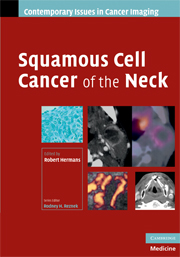Book contents
- Frontmatter
- Contents
- List of contributors
- Series Foreword
- Preface to Squamous Cell Cancer of the Neck
- 1 Introduction: epidemiology, pathology and clinical presentation
- 2 Radiotherapy and chemoradiotherapy of the head and neck
- 3 Surgery of the orocervical region
- 4 Laryngeal and hypopharyngeal cancer
- 5 Oral cavity and oropharyngeal cancer
- 6 Nasopharyngeal cancer
- 7 Neck and distant disease spread
- 8 Post-treatment imaging
- Index
- Plate section
Preface to Squamous Cell Cancer of the Neck
Published online by Cambridge University Press: 24 August 2009
- Frontmatter
- Contents
- List of contributors
- Series Foreword
- Preface to Squamous Cell Cancer of the Neck
- 1 Introduction: epidemiology, pathology and clinical presentation
- 2 Radiotherapy and chemoradiotherapy of the head and neck
- 3 Surgery of the orocervical region
- 4 Laryngeal and hypopharyngeal cancer
- 5 Oral cavity and oropharyngeal cancer
- 6 Nasopharyngeal cancer
- 7 Neck and distant disease spread
- 8 Post-treatment imaging
- Index
- Plate section
Summary
Squamous cell cancer is one of the most common neoplasms in the head and neck. In this complex anatomical environment, accurate staging of neoplasm is a challenging task. As these lesions originate from the mucosal lining, the clinician is often able to detect their presence; however, it may be difficult or impossible to appreciate, based on the physical examination, the entire submucosal tumor extension, or the possible regional and distant disease spread.
Modern imaging tools provide a reliable visualization of the head and neck tissues. Carefully performed cross-sectional imaging allows an accurate evaluation of the local and regional cancer extent, and the exclusion or detection of distant metastasis.
The radiologist is an important member of the multidisciplinary team managing patients with head and neck cancer. Recent evolutions, such as positron emission tomography–computed tomography (PET–CT) and diffusion-weighted magnetic resonance imaging, have further increased the impact of imaging in oncological patient care. The added value of existing imaging techniques, such as CT, in choosing the optimal treatment strategy and in monitoring tumor response, is now scientifically established.
The purpose of this book is to review state-of-the-art imaging in head and neck squamous cell cancer, and to describe its role within the overall diagnostic and therapeutic management of this disease.
- Type
- Chapter
- Information
- Squamous Cell Cancer of the Neck , pp. ix - xPublisher: Cambridge University PressPrint publication year: 2008

